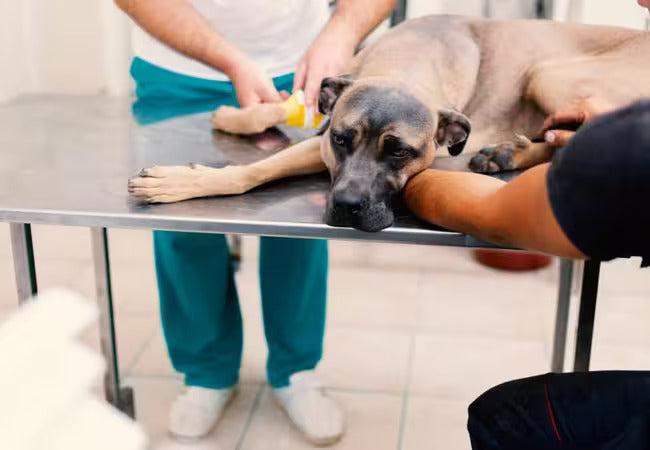Vet’s 2025 Guide to Traumatic Shock in Dogs Recognize, Respond & Recover🩺

In this article
Vet’s 2025 Guide to Traumatic Shock in Dogs Recognize, Respond & Recover🩺
By Dr. Duncan Houston BVSc
💡 What Is Traumatic Shock?
Shock is a potentially fatal emergency where tissues and organs fail due to critically low blood flow or oxygen delivery, often caused by trauma (e.g., vehicle hit, bite wounds), massive bleeding, heatstroke, poisoning, or severe allergic reactions.
🚩 Causes & Types of Shock
- Hypovolemic Shock: blood or fluid loss from trauma, burns, diarrhea/vomiting.
- Cardiogenic Shock: heart failure or arrhythmias.
- Anaphylactic Shock: severe allergic response leads to vessel dilation, fluid leakage into tissues, and airway swelling.
- Neurogenic Shock: nerve damage from trauma leading to vessel dilation.
- Septic Shock: overwhelming infection causing vessel leakage and low pressure.
👀 Warning Signs & Shock Stages
Early Stage (Compensated)
- Rapid heart rate, bounding pulse
- Bright red or warm gums with fast capillary refill
- Anxious, restless, panting, shivering
Middle to Late Stage (Decompensated)
- Pale, white, or bluish gums; prolonged refill (>2 sec)
- Weak, thready, or absent pulses; cold extremities
- Low body temperature, shallow, rapid breathing; collapse, or unconsciousness
- Vomiting, diarrhea or urinary issues may occur
🛠 Immediate First‑Aid (Pre‑Vet)
- 📱 Call your vet or emergency clinic immediately.
- ⬆️ Position: lie dog on right side, lift hindquarters slightly on blanket to promote blood flow to heart/brain.
- 🧣 Cover with blanket to maintain warmth; cold worsens shock.
- 🚫 Do not give food or water—may need surgery/anesthesia.
- 🏥 If bleeding externally, apply firm pressure with a clean cloth.
- 🩹 Stabilize fractures with makeshift splints or rigid supports.
- 🚑 Transport quickly but gently—minimize movement in neck/spine injuries.
🔍 Veterinary Diagnostics
- Physical exam: HR/pulse, BP, mucous membranes, lung/heart auscultation, temperature, responsive status.
- Bloodwork: CBC, chemistry, lactate (perfusion marker), clotting profile.
- Imaging: X‑rays for fractures, chest injury, ultrasound (FAST) to detect bleeding.
- ECG: to identify arrhythmias in cardiogenic or traumatic cases.
- Allergy evaluation: for suspected anaphylaxis (history of exposure, rapid swelling, collapse).
- Culture/Sampling: in septic cases—blood, urine, wounds.
🏥 Emergency Treatment Protocol
1. Respiratory Support & Oxygen
- Administer high-flow oxygen via mask, nasal cannula, or tent.
- Intubate and ventilate if respiratory failure or airway obstruction.
2. Intravenous Fluids
- Begin with isotonic crystalloid boluses (10–20 ml/kg), reassessing frequently.
- Monitor for overload in cardio cases; adjust volume accordingly.
3. Hemorrhage Control & Transfusion
- Manage external bleeding; surgical exploration for internal hemorrhage.
- Begin blood transfusion if PCV <20–25%, signs of anemia, or ongoing blood loss.
4. Medication Support
- Inotropes (e.g., dobutamine) or vasopressors (e.g., norepinephrine) for hypotension not responsive to fluids.
- IV broad-spectrum antibiotics for septic shock.
- Antihistamines and epinephrine in anaphylaxis cases.
5. Pain Control & Support Measures
- Analgesics like opioids are used for pain relief.
- Anti-nausea support, warming, and stress reduction.
- Calm environment to reduce anxiety and sympathetic exhaustion.
6. Monitoring in the ICU
- Continuous ECG, BP, pulse oximetry, respiratory rate, urine output.
- Repeat labs: lactate, electrolytes, organ function.
- Frequent exams for bleeding, limb perfusion, and mentation.
📈 Prognosis & Recovery
- Early recognition and rapid treatment improve survival greatly.
- Mortality depends on cause—hypovolemic/septic shock has a 30–70% risk without timely care.
- Full recovery possible with prompt management; long-term care may be needed for complications.
- Dogs surviving the first 48–72 hours often stabilize and recover with continued ICU care.
🚫 Prevention & Owner Tips
- Avoid trauma: keep dogs leashed, crated in vehicles, and on safe property.
- Act fast if signs arise—don’t wait.
- Maintain weight, hydration, and treat chronic diseases.
- Carry emergency kit: blanket, tourniquet-like material, soft muzzle.
🏡 Ask A Vet Home Support Tools
- 🗓 Medication & follow-up reminders—fluids, pain meds, antibiotics.
- 📊 Track vitals: gum color, pulse quality, activity, and appetite.
- 📸 Upload photos/videos of wounds, gait, breathing.
- 🔔 Get alerts for warning signs—pale gums, collapse, rapid breathing.
- 📚 Access guides: post-trauma wound care, recheck scheduling, home comfort tips.
🔑 Key Takeaways
- Shock is a critical emergency—low blood flow causes organ failure.
- Causes include trauma, bleeding, allergies, infection.
- Early shock looks compensated—restlessness, rapid pulse; later stage shows pale gums, weak pulse, collapse.
- First-aid warms, supports, stops bleeding, and avoids giving food/water.
- Veterinary care requires oxygen, IV fluids, hemorrhage control, medications, and ICU monitoring.
- Ask A Vet app equips you to support recovery with structured tools and remote guidance.
🩺 Final Thoughts ❤️
In 2025, traumatic shock remains a top pet emergency—but early recognition, rapid action, and advanced hospital care mean many dogs survive and thrive. As a pet parent, having the knowledge, tools, and support systems like Ask A Vet can be lifesaving. 🐾✨
Visit AskAVet.com and download the Ask A Vet app to log meds, record signs, upload pics/videos, schedule vet checks, and stay connected with expert guidance anytime. 📲






